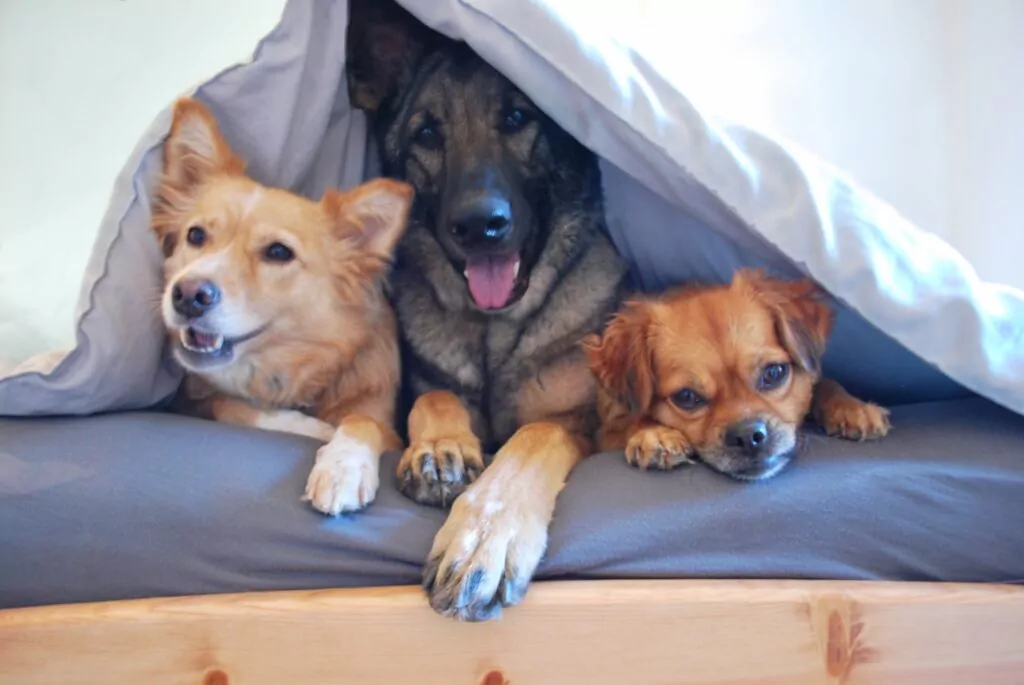Ever wondered if your furry friend is too hot or too chilly at home? You’re not alone! Keeping our dogs comfortable is more than just a luxury; it’s essential for their health and happiness.
The magic numbers? Aim for between 68°F to 72°F (20°C to 22°C). This range is generally comfy for most pups, but remember, every dog is unique.
Factors like breed, fluffiness, and age can tweak their personal thermostat settings. Too cold, and they might shiver their way into discomfort; too warm, and you’re looking at a panting, unhappy pooch. Let’s dive into the cosy-to-toasty spectrum of dog well-being indoors, ensuring tails keep wagging in the perfect climate.
What is the Ideal Indoor Temperature for Dogs?
Maintaining an ideal indoor temperature for dogs is crucial for their comfort and health. Generally, the recommended temperature range falls between 68°F to 72°F (20°C to 22°C). This range is considered safe and comfortable for most breeds, ensuring they are neither too hot nor too cold.
However, it’s important to consider the specific needs of your dog, such as their breed, size, and coat type, as some dogs may require slightly warmer or cooler temperatures to feel comfortable. For example, breeds with thick fur might prefer cooler temperatures, while those with short coats may need a warmer environment. Adjusting your home’s temperature within this range can help prevent your dog from experiencing heat stress or cold discomfort.
Moreover, it’s essential to observe your dog for signs that they might be too hot or too cold, such as excessive panting or shivering, and adjust the temperature accordingly. Providing a comfortable indoor environment plays a significant role in promoting your dog’s overall well-being and happiness.
How Does Too Cold of an Indoor Temperature Affect Dogs?
When indoor temperatures drop too low, dogs face several health risks, including the risk of hypothermia. This condition occurs when a dog’s body temperature falls below normal, leading to signs such as shivering and lethargy, which are clear indicators of discomfort. Additionally, cold environments can exacerbate joint discomfort, particularly in arthritic or elderly dogs, making it difficult for them to move around comfortably.
Ensuring indoor temperatures remain within a dog-friendly range is crucial to prevent these adverse effects and maintain their well-being.
Risk of Hypothermia
Exposure to cold temperatures can lead to hypothermia, a condition where the body’s temperature drops dangerously low.
Signs Include Shivering and Lethargy
Shivering and lethargy are primary indicators that a dog may be suffering from hypothermia and discomfort due to cold.
Joint Discomfort
Cold weather can increase joint discomfort, making mobility a challenge, especially in arthritic or elderly dogs.
How Does Too Hot of an Indoor Temperature Affect Dogs?
Elevated indoor temperatures put dogs at a significant risk of heatstroke. Symptoms of overheating in dogs include excessive panting and drooling, which are immediate signs of distress. Additionally, dehydration is a serious concern, with symptoms such as dry gums and decreased skin elasticity indicating a need for immediate intervention.
It’s crucial for dog owners to recognise these signs early and ensure their pets are kept in a comfortably cool environment to prevent heat-related hazards.
Risk of Heatstroke
High indoor temperatures increase the risk of heatstroke, a critical condition that requires immediate attention.
Symptoms Include Excessive Panting and Drooling
Excessive panting and drooling are key symptoms indicating a dog is overheating and potentially at risk of heatstroke.
Dehydration
Dehydration is a significant concern in hot conditions, with dry gums and decreased skin elasticity serving as warning signs.
What are Signs of Discomfort in Dogs Due to Inappropriate Temperatures?

Signs of discomfort in dogs due to inappropriate temperatures can manifest in various ways. Excessive shivering is a clear indicator of potential hypothermia in cold conditions, while lethargy can signal discomfort in both too hot and too cold environments. Panting often signifies overheating, a precursor to more serious conditions such as heatstroke.
Additionally, excessive thirst indicates dehydration, often a result of excessive heat. Recognising these signs early is crucial for preventing temperature-related health issues in dogs and ensuring their well-being.
Excessive Shivering
Indicates potential hypothermia.
Lethargy
It can signal either too hot or too cold environments.
Panting
Often a sign of overheating.
Excessive Thirst
Indicates dehydration, often due to heat.
How can You Maintain an Ideal Indoor Temperature for Dogs?
Maintaining an ideal indoor temperature for dogs involves using thermostats to regulate the environment, setting them between 68°F and 72°F for optimal comfort. Providing insulated bedding can offer additional warmth for cold-sensitive breeds, ensuring they stay comfortable even when the temperature drops. Ensuring proper hydration is also crucial; dogs should have access to fresh water at all times to prevent dehydration, especially in warmer conditions.
By taking these steps, dog owners can create a safe and comfortable indoor environment that caters to the well-being of their pets across various temperatures.
Use of Thermostats
Set between 68°F and 72°F.
Providing Insulated Bedding
Especially for cold-sensitive breeds.
Ensuring Proper Hydration
Access to fresh water at all times.
What are the Breed-specific Considerations for Indoor Temperatures?
Breed-specific considerations for indoor temperatures are crucial for ensuring the comfort and health of dogs. Short-haired breeds are more susceptible to cold, requiring warmer indoor environments to maintain their well-being. On the other hand, brachycephalic breeds, with their unique respiratory systems, have a higher risk of heatstroke, necessitating cooler temperatures to prevent overheating.
Northern breeds, accustomed to cold climates, tolerate lower temperatures better but may overheat easily in warm conditions. Recognising and accommodating these breed-specific needs helps create a safe and comfortable indoor environment for all dogs.
Short-haired Breeds
More susceptible to cold.
Brachycephalic Breeds
Higher risk of heatstroke.
Northern Breeds
Tolerate cold better but may overheat easily.
Comfort Starts with Climate
Your dog’s comfort isn’t just about cosy beds and belly rubs, it starts with the right indoor temperature. From avoiding heatstroke to preventing the chills, keeping your space in the sweet spot between 68°F and 72°F can make a world of difference for their health and happiness.
At Soulmutts Toronto, we take climate control seriously. Our indoor environments are designed with your dog’s comfort in mind. Whether they’re a fluffy Malamute or a sleek Greyhound, they’ll feel right at home.
Curious about how we keep tails wagging year-round? Reach out to Soulmutts today and discover a boarding experience that’s as temperature-perfect as it is dog-approved.
